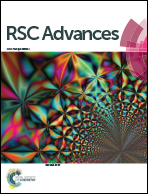Fabrication of highly visible-light-responsive ZnFe2O4/TiO2 heterostructures for the enhanced photocatalytic degradation of organic dyes†
Abstract
In this study, a novel visible-light-sensitive ZnFe2O4–TiO2 photocatalyst has been fabricated by coupling 0.2–2 wt% p-type ZnFe2O4 narrow bandgap material with n-type anatase TiO2 for the enhanced photocatalytic degradation of organic dyes under 465 nm visible light irradiation. Transmission electron microscopy (TEM) and high resolution TEM confirm that ZnFe2O4 and TiO2 are strongly linked with an average particle size of 8–9 nm, leading to a decrease in hole–electron recombination rate as well as the enhanced photocatalytic activity of the ZnFe2O4–TiO2 heterostructures under visible light irradiation. The optimized 1 wt% ZnFe2O4 not only significantly extends the absorption edge of TiO2-based heterostructures to the visible light region but can also retain a stable photodegradation efficiency of >99% for at least 5 cycles. In addition, the photocatalytic activity of ZnFe2O4–TiO2 toward dye decomposition follows the order cationic rhodamine B > neutral methyl red > anionic methyl orange. Our results clearly demonstrate that the coupling of a low loading mass of ZnFe2O4 with anatase TiO2 is a reliable green technology approach to prepare visible-light-responsive heterostructure photocatalysts with great potential for application in the decomposition of organic dyes and other emerging pollutants in the treatment of water and wastewater.



 Please wait while we load your content...
Please wait while we load your content...